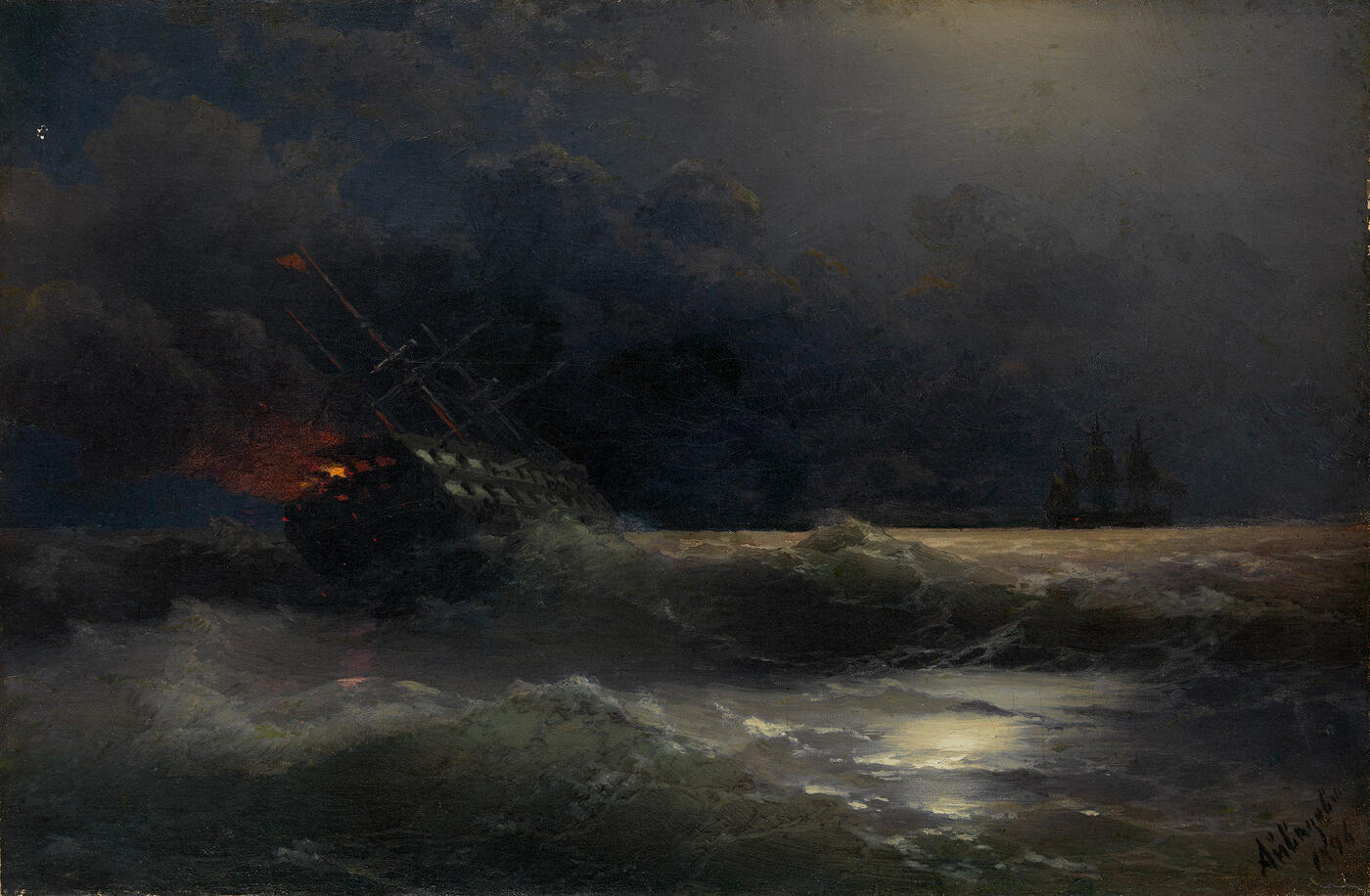MacDougall's Russian Art Auctions 8-9 June 2011
8 June 2011

93. AIVAZOVSKY, IVAN (1817-1900)
The Burning Ship , signed and dated 1896.
Oil on canvas, 30.5 by 46 cm.
130,000-180,000 GBP
Provenance: Private collection, Czech Republic.
Authenticity of the work has been confirmed by the experts N. Ignatova, G. Goldovsky and V. Petrov.
In The Burning Ship Aivazovsky remained true to the themes and compositional techniques which had made his name. This greatest of Russian seascape artists had painted a series of pictures featuring incidents in the Crimean and Russo-Turkish wars (of 1853-1856 and 1877-1878 respectively), and it was while working on these that the subject of a sailing ship which has caught fire and is sinking into a stormy sea entered his mental treasury of motifs.
Thanks to this earlier experience, the artist developed his favourite shipwreck theme with the addition of fire, which strengthened the drama of the scene and evoked a sense of the inevitable loss of the ship, enveloped in flames and smoke, and of the daring men trying to swim to safety. These variations on the much-used "storm at sea" motif, embellished with new Romantic effects, enabled the artist to build his composition on the startling contrast between the night sky and the ship and sea, lit up by flames.
In works such as this, it is as if Aivazovsky were looking for the most spectacular, but equally the most tragic, shipwreck situation. From one picture to the next he strove to raise the emotional pitch. "I have often portrayed shipwrecks in my paintings, but viewers have only seen them from a distance, guessing with their heart and their imagination at the horrors unleashed within the fragile wooden walls being destroyed by the waves…"
Aivazovsky spent much of his career endeavouring to convey the most subtle and complex of elemental conditions encountered at sea, to fix and capture the moment of impending disaster in his canvases, and again and again he chose the "burning ship" as his protagonist. For the colour schemes of these pictures comprise a vast multitude of tones which, glow on the water alongside the burning boat, and are intensified under the cover of darkness or the ray of light which pierces the composition diagonally. This technique, used time and time again by this artist, was a sure way of creating the colour and light effects and high emotional charge of the portrayal.
Of all Aivazovsky's known "burning ships", the picture now offered at auction holds a highly respected and prestigious position, noted for the high quality of its execution. Painted in the year of Aivazovsky's solo jubilee exhibition (his 120th exhibition!), it reveals the same features of "inspired improvisation" as the majority of this master's canvases of the period. Having visited the St Petersburg exhibition in the winter of 1896, his contemporaries noted the ease with which he could produce a sketch of a stormy sea on a prepared canvas or paper, literally in the space of an hour, most frequently turning to subjects with night-time or pre-dawn lighting conditions.
The artist himself saw his artistic path in the 1890s as a never-ending quest to refine his work. His tireless, and virtually uninterrupted, labour on the same motifs was dictated by this perception that his pictures were unfinished. "I am not quite satisfied with them… I am trying, as best I can, to correct earlier shortcomings, which is why I need to repeat earlier subjects and motifs," he wrote in the last year of his life. And indeed, in each of his "burning ships", there was always something new to be found.
Even the large-scale Exploding Ship, which was to be his last pic
ture, left unfinished on the artist's easel, yet again used to good effect the subject which had been such a blessing to Aivazovsky, that of the burning ship.
Notes on symbols:
* Indicates 5% Import Duty Charge applies.
Ω Indicates 20% Import Duty Charge applies.
§ Indicates Artist's Resale Right applies.
† Indicates Standard VAT scheme applies, and the rate of 20% VAT will be charged on both hammer price and premium.